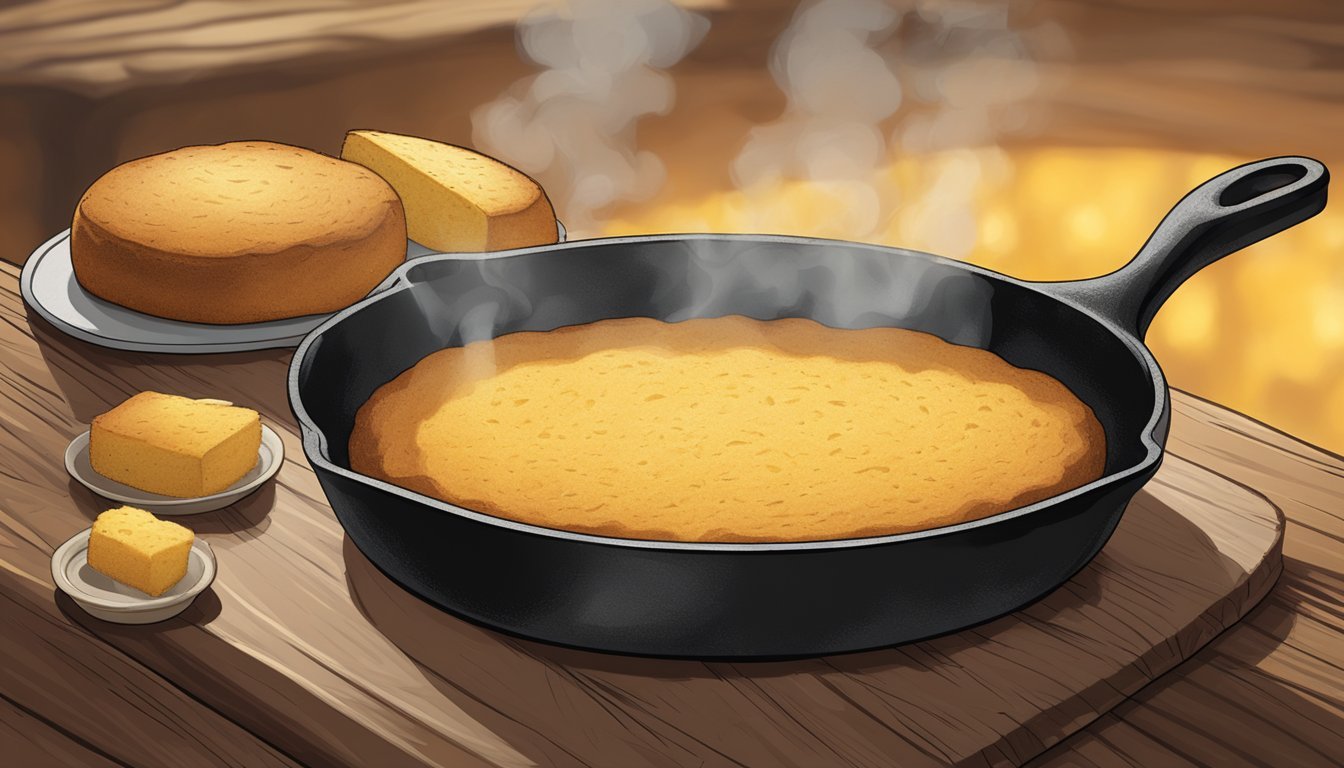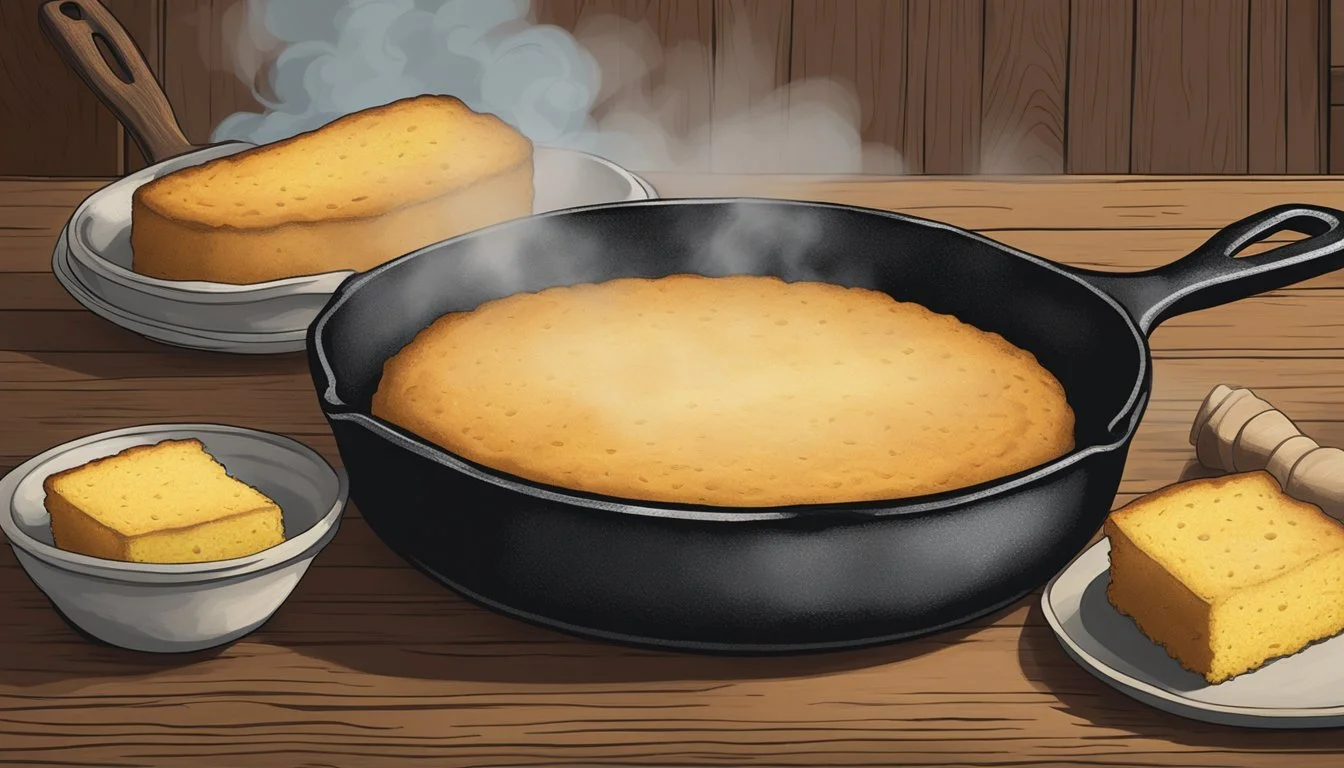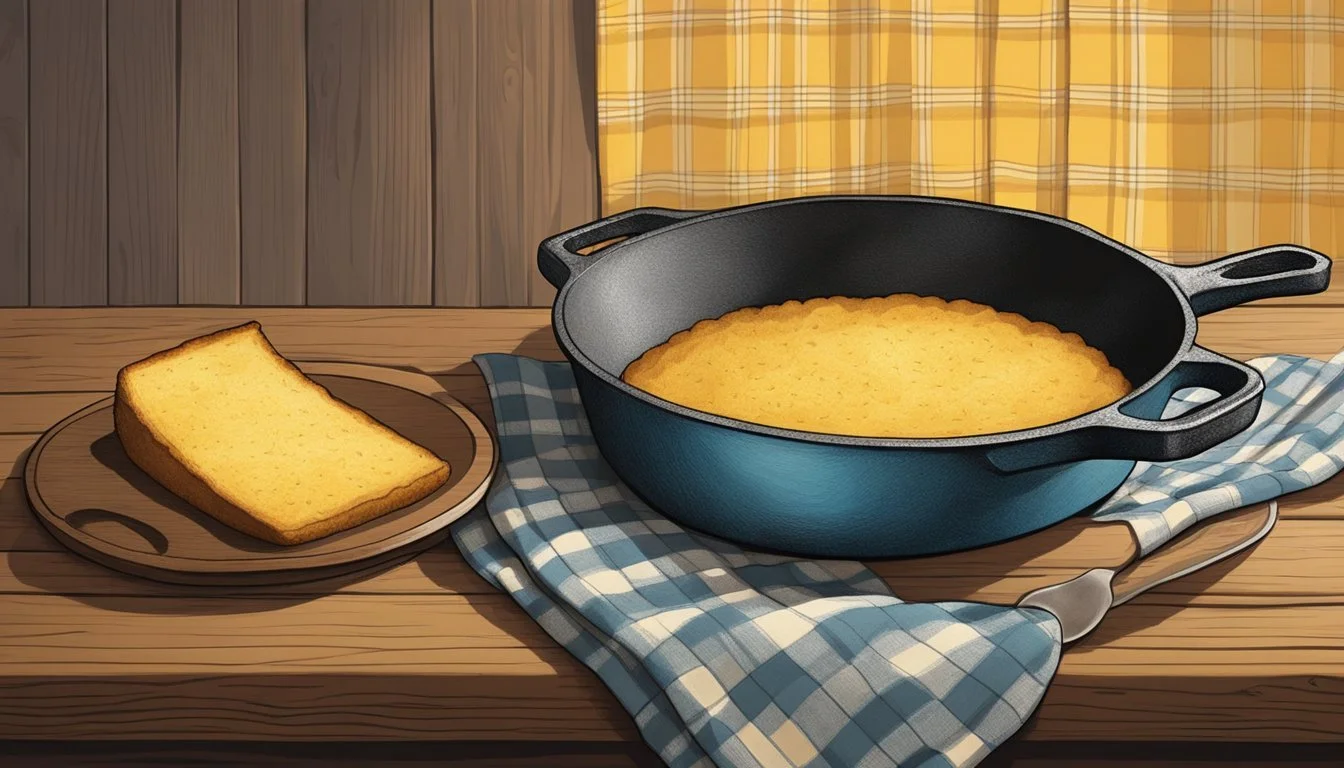The Cast Iron Cornbread
Mastering a Southern Classic in Any Oven
Cast iron cornbread stands as a testament to the adaptability and timelessness of Southern cuisine. Known for its rich flavor and comforting texture, this delectable bread has been a staple in American Southern cooking for generations. Traditionally baked in a cast iron skillet, which imparts a distinctive crispy crust and even heating, cornbread exemplifies the simplicity and heartiness of the South's culinary heritage. Its practicality shines as it doesn't exclusively rely on a Southern oven, but can be prepared with whatever heat source is available, making it a versatile dish for many occasions.
The allure of cast iron cornbread is evident in its straightforward ingredient list and the ease with which it can be customized. Simple yet satisfying, the bread is made using basic components such as cornmeal, buttermilk, and eggs, and does not necessarily require sugar, aligning with Southern preferences for a less sweet cornbread. This simplicity allows the natural flavors and textures to be the stars, while also providing a canvas for additional ingredients like jalapeños, cheese, or bacon, adapting to modern palates while remaining rooted in tradition.
Cornbread's adaptability has also led to innovative cooking methods beyond the typical preheated oven. Skilled home cooks and professional chefs alike have mastered the art of stovetop preparation, ensuring that the pleasure of a freshly baked cornbread is never far out of reach. The technique involves heating the skillet on the stovetop, then pouring in the batter for a quick and satisfying bread, showing that even without a conventional Southern oven, the iconic cast iron cornbread thrives, continuing to foster connections over shared meals and cherished memories.
The History and Origin of Southern Cornbread
Southern cornbread is deeply rooted in the cultural fabric of American culinary history. This staple, known for its simplicity and rich flavor, originated from the Native American tribes who utilized ground maize as a primary source of food. As European settlers arrived, they adopted this indigenous practice, and over time, it evolved into the classic Southern cornbread revered today.
The traditional Southern cornbread is distinct from its sweeter counterparts found in other regions of the United States. Traditional Southern cornbread typically avoids the use of sugar, relying instead on the natural sweetness of the cornmeal. It is known for its savory profile, with a dense, crumbly texture that comes from the use of plain yellow cornmeal and buttermilk. The baking method of choice involves a cast iron skillet, which imparts a characteristic crisp crust and even heating that can't be replicated with other types of cookware.
Cast iron cornbread reflects not just a cooking method, but a legacy passed down through generations. The pre-heated skillet ensures a rapid rise and the delightful crust that is a hallmark of this regional dish. The frequent use of bacon drippings to grease the pan adds another layer of traditional flavor. Here, then, is a brief overview of how the three elements combine to define Southern cornbread:
Cornmeal: Milled from dried corn, creating a sweet, earthy base.
Buttermilk: Adds a tangy depth and contributes to the bread's moisture.
Cast iron skillet: Provides superior heat retention for a crispier edge.
It is the marriage of these components and traditions that solidifies Southern cornbread as a timeless icon in Southern cuisine.
Understanding the Key Ingredients
Crafting the perfect cast iron cornbread involves a symphony of key ingredients that work in harmony to create its distinctive taste and texture. This section delves into the foundational elements that contribute to the classic Southern cornbread's flavors and structural integrity.
Cornmeal and Flour Varieties
Cornmeal: The cornerstone of cornbread, available as either yellow or white cornmeal, provides the bread's characteristic grainy texture and subtle sweetness. Self-rising cornmeal mix combines cornmeal with a rising agent and salt for convenience.
Flour: All-purpose flour is often mixed with cornmeal to give cornbread a softer crumb. The ratio of flour to cornmeal can vary, affecting the bread's density and chewiness.
Leavening Agents and Their Role
Baking Powder and Baking Soda: These are crucial for the cornbread's rise. Baking powder acts independently when wet and during heating, while baking soda partners with acidic buttermilk to create lift, ensuring a fluffy interior.
Dairy Inputs: Buttermilk and Eggs
Buttermilk: Its acidity reacts with leavening agents, imparting a slight tanginess and tenderizing the crumb.
Eggs: Serve as a binding agent, adding structure and richness to the cornbread.
Fats for Flavor and Texture
A variety of fats can be used, each imparting its own flavor profile and affecting the cornbread's moisture:
Butter: Offers a rich flavor and contributes to a softer crumb.
Lard or Bacon Grease: Provide a traditional, savory depth.
Vegetable Oil: Ensures moisture and creates a tender texture.
Sweet vs. Savory Variations
Cornbread can tip the scales toward savory or sweet:
Sweet Cornbread: Incorporates sugars like white sugar or honey.
Savory Cornbread: Opts out of sugar, focusing on the natural flavors and may include additions like jalapenos or cheese.
Additional Enhancements
Cornbread's versatility allows for a range of enhancements:
Cheese: For a richer taste and melted texture.
Jalapenos or Chili: To infuse the bread with a spicy kick.
Important Nutritional Information
Cornbread contains vital nutrients but also considerable levels of calories, cholesterol, and sodium. Key nutritional components per slice approximately include:
Calories: 190
Protein: 4g
Carbohydrates: 28g
Fiber: 2g
Calcium: Offering a daily value of 1%.
Other significant nutrients are vitamin A, potassium, and calcium. Depending on the choice of fat, the cornbread can also contain saturated, monounsaturated, and polyunsaturated fats, with an aim to limit trans fat intake.
Cast Iron Skillet: The Culinary Cornerstone
A cast iron skillet is essential for creating the unmistakable golden-brown crust and rich flavor of authentic skillet cornbread. It imparts an even, high heat conducive to the perfect texture.
Benefits of Using a Cast Iron Skillet
The use of a cast iron skillet for cornbread is not just tradition; it is a choice backed by distinct benefits:
Heat Retention: Cast iron skillets excel at retaining and distributing heat evenly, resulting in consistent cooking and a delectable golden color.
Flavor Enhancement: Cooking in cast iron can enhance the flavor profile of cornbread, giving it a distinctive, slightly metallic taste that complements its savoriness.
Versatility: Suitable for use on the stovetop, in the oven, or even over an open flame, making it a flexible cooking tool.
Non-Stick Qualities: A properly seasoned skillet provides a natural non-stick surface that is ideal for achieving a crispy crust.
Seasoning and Maintenance of Cast Iron
Maintaining a cast iron skillet ensures its longevity and performance:
Seasoning:
Essential for creating the non-stick surface.
Achieved by baking a layer of oil into the skillet at high heat, forming a protective coating.
Care:
Should be cleaned with hot water and a stiff brush, avoiding soap which can remove the seasoning.
Dry immediately and apply a light coat of oil before storing.
Cooking Techniques for Perfect Cornbread
The method of preparing cornbread in a cast iron skillet can greatly influence its quality:
Preheating: Place the skillet in the oven as it preheats to an optimal temperature of 400°F to 425°F, which promotes a crispy crust.
Batter Handling: Mix the batter until just combined. Overmixing may lead to a denser cornbread with less desirable texture.
Testing Doneness: Insert a toothpick or skewer into the cornbread; it is done when it comes out clean.
Alternative Cooking Methods
While the oven is the traditional choice, other methods can be used for making cornbread in a cast iron skillet:
Stovetop: For a crispy bottom crust, cook batter over medium-high heat before transferring to the oven to finish.
Alternative Appliances: Devices like the Instant Pot can be used to make cornbread, although the results may vary from the traditional skillet method.
Muffin Tin: For individual servings, a cast iron muffin tin can be used, giving each piece a crispy edge and a moist interior.
Using a cast iron skillet for cornbread baking allows for a versatile, rich culinary experience that highlights the skillet's ability to produce golden, flavorful, and textured food. Whether pairing with Instant Pot collard greens or enjoying it as is, the cast iron skillet remains a cornerstone in the kitchen for baking this Southern classic.
Mastering the Recipe
Mastering the Southern cornbread recipe involves precise steps, considerations for dietary restrictions, and the introduction of distinct regional flavors. This section provides guidance on baking a classic cornbread, making substitutions to accommodate dietary needs, and enhancing the recipe with traditional Southern ingredients.
Basic Steps for Traditional Southern Cornbread
To bake traditional Southern cornbread, start by heating a cast iron skillet in the oven at 425°F (220°C). The skillet's heat is crucial for achieving the crusty bottom.
Preparation: In a large bowl, combine wet ingredients, typically whisking together buttermilk, eggs, and oil or melted butter.
Dry Ingredients: In a separate bowl, whisk together the dry components, usually consisting of cornmeal, flour, baking powder, and salt.
Combining: Pour the wet mix into a well in the dry ingredients, stirring until just combined to keep the batter lumpy.
Baking: Pour the batter into the preheated skillet and bake until the cornbread is golden and a tester comes out clean, around 20 to 25 minutes.
Tweaks and Substitutes for Dietary Needs
Many people have dietary restrictions, but that shouldn't stop anyone from enjoying Southern cornbread.
Gluten-Free: Substitute the all-purpose flour with a gluten-free flour blend. Make sure the cornmeal is certified gluten-free.
Dairy-Free: Replace buttermilk with a mixture of dairy-free milk and vinegar to replicate the tanginess, and use oil in place of butter.
Incorporating Regional Flavors
Southern cornbread can be customized with ingredients that reflect the region's culinary traditions.
For a Hearty Variant: Add cooked, crumbled bacon or ham to the batter. Bacon drippings can also be used as the fat component to enrich the flavor.
Vegetables: Fold in diced collard greens or other greens to introduce a subtle, earthy taste.
Beans: Stir in cooked pinto beans for added texture and protein, making a complete meal in itself.
Pairings and Serving Suggestions
When serving cast iron cornbread, the dish's versatility shines as it pairs well with an array of foods across various meals, from breakfast to dinner. Its classic flavor profile complements both savory and sweet accompaniments.
Classic Accompaniments
Cast iron cornbread traditionally comes alongside a range of savory southern dishes, making it a staple easy side dish. Here are some well-loved pairings:
Soup and Chili: The slightly sweet flavor of cornbread balances the spicy and savory notes in chili and adds substance to brothy soups.
Barbecue: Whether it’s pulled pork or ribs, the cornbread's texture is perfect for sopping up excess sauce.
Seafood: Especially with dishes like shrimp or fish, cornbread provides a sturdy yet delicious contrast.
Cornbread Dressing: Often crumbled and used as a base for a rich and flavorful side, perfect for holiday dinners.
Fried Favorites: Cornbread complements the crunch of fried chicken and other southern fried dishes, absorbing the flavors and juices well.
Innovative Combinations
Beyond the classics, cornbread's unique flavor lends itself to some creative culinary pairings:
Jam: Adding a sweet layer on top brings out cornbread's inherent sweetness.
Salad Dressing: Crumbled as croutons or served on the side, it can add texture to salads with zesty dressings.
Hoe Cakes: When made into cornbread pancakes, these hoe cakes can be paired with a variety of toppings from savory to sweet.
Seafood: In innovative southern cooking, cornbread can be paired with spicy, creole-seasoned dishes for a delightful contrast.
Suggested Times of Day to Serve
Cornbread's adaptability makes it suitable for every meal, providing an easy side with satisfying flavor.
Breakfast: Serve it warm with honey, butter, or as part of a hearty southern breakfast with eggs and bacon.
Lunch: Pair a slice with a classic salad or soup to enhance a midday meal with extra comfort.
Dinner: As the cornerstone of a southern dinner, cornbread can accompany almost any main dish but shines particularly with barbecue and fried foods (What wine goes well with fried foods?).
Care and Keeping of Leftovers
Preserving the freshness and quality of leftover cornbread is just as important as achieving the perfect crust. Attending to proper storage methods and reheating practices ensures the cast iron cornbread retains its delightful texture and flavor.
Proper Storage Solutions
To maintain the cornbread’s moisture and prevent drying out, leftovers should be stored in an airtight container or wrapped tightly with plastic wrap. Storage in the refrigerator can extend freshness, but it should be noted that cornbread kept in the fridge for more than a few days may begin to dry out. A cool, dry pantry or countertop may suffice for short-term storage of up to two days.
Reheating Without Losing Quality
Reheating cornbread traditionally in an oven can help preserve its original quality. The optimal reheating temperature is around 350°F, warming the cornbread for 10 to 15 minutes. Wrapping the cornbread in aluminum foil can prevent it from drying out. For those wanting to recreate that crisp edge, placing the cornbread in a cast-iron skillet over low heat for a few minutes can achieve this without sacrificing the soft interior.
Reader Questions and Interactions
This section addresses common inquiries and provides a platform for readers to engage with the content and share their experiences. It ensures the dialogue is ongoing, inviting readers to contribute to the community with their own insights and suggestions.
Frequently Asked Questions
How do I prevent my cornbread from sticking to the cast iron skillet?
Ensure the skillet is well-seasoned and place it in the oven to heat with oil or butter before adding the batter.Can I make cornbread without a cast iron skillet?
A cast iron skillet is ideal for even heating but you may use a different oven-safe pan, adjusting bake time as necessary.
Responding to Feedback
Readers may leave comments about their attempts, adjustments to the recipe, or ask for clarifications. Responses should be:
Prompt: Aim to reply to reader comments within a given timeframe to maintain engagement.
Encouraging: Celebrate successes and offer constructive advice for less successful attempts.
Community Contributions
Readers are encouraged to share:
Photos: They can post images of their cornbread, highlighting their unique touches.
Tips: Readers with alternative methods or ingredient substitutes can offer their advice to the community.
Suggestions for Future Topics
Recipes: Readers may suggest exploring variations of cornbread or other Southern dishes.
Techniques: Interest may arise in diving deeper into the art of seasoning and maintaining cast iron cookware.
Readers' suggestions play a crucial role in shaping future content, ensuring it reflects the interests and needs of the community.
Conclusion
Cast iron cornbread has solidified its place as a cherished staple in the culinary world. Its versatility allows it to be cooked to perfection without the requirement of a Southern oven, making it accessible to chefs and home cooks everywhere. The key to an exceptional batch lies in the preheated cast iron skillet, which ensures a consistent temperature and contributes to the signature crisp exterior and moist interior.
One should remember these essential tips:
Preheat the skillet: This step is non-negotiable for achieving the coveted crust.
Butter or oil: A generous amount aids in the effortless release of the bread from the skillet.
Avoid overmixing: To keep the texture of the cornbread tender, mix the batter just until combined.
No peeking: Resist the temptation to open the oven door frequently, as this can cause the temperature to drop.
This dish's adaptability to various mix-ins and toppings ensures its relevance across countless dining tables. It's an homage to Southern traditions with a universal appeal. Whether one enjoys it with a smear of butter, a drizzle of honey, or as a side to a steaming bowl of chili, the cast iron cornbread holds its own as a simple yet sophisticated bread that never disappoints.




